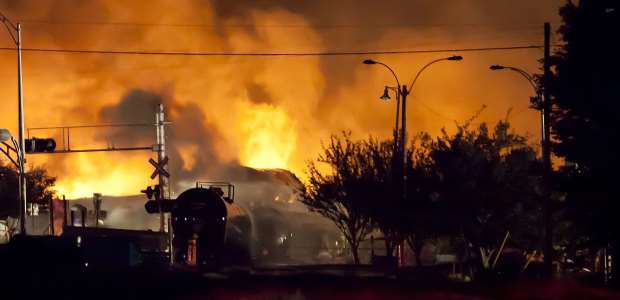
Clock Ticking for Comments on Railcar Securement Rule
"Requiring that an additional, trained individual double check that the handbrakes have been set on a train will help stop preventable accidents," said FRA Acting Administrator Sarah Feinberg.
Stakeholders and the American public have roughly 60 days to submit comments about the Federal Railroad Administration's final rule meant to prevent unattended trains that carry crude oil, ethanol, poisonous by inhalation, toxic by inhalation, and other highly flammable contents from rolling away. The final rule was promulgated in response to the 2013 disaster in Lac-Mégantic, Canada, when an unattended train rolled into the town, derailed, causing an explosion and fire that killed 47 people and destroyed much of the town's central area.
The July 6, 2013, disaster involved a 74-car freight train carrying Bakken crude oil. The Canadian government found that there were nearly 20 causes of the accident, but a major cause was that the engineer of the train did not properly secure the train, according to FRA, which said "railroad employees who are responsible for securing a train will now be permanently required to communicate with another qualified individual trained on the railroad's securement requirements to verify that trains and equipment are properly secured."
U.S. Transportation Secretary Anthony Foxx said the rule "is part of the Department of Transportation's comprehensive effort to bolster the safety of trains transporting crude oil and other highly flammable contents. Verifying that a train has been properly secured is a common-sense solution to prevent accidents."
The rule requires:
- A qualified and trained railroad employee to properly secure the equipment and verification of the securement with a second trained and qualified employee
- Additional communication, including job briefings among crew members responsible for the train securement
- Properly installed and utilized exterior locks on locomotives
- Sufficiently set handbrakes
- Removal of the train reverser
- Proper use of train air brakes
The rule applies to the following trains left unattended on a mainline, siding, and rail yard:
- Trains carrying any poisonous by inhalation (PIH) and toxic by inhalation (TIH) hazardous materials
- Trains carrying 20 or more cars of other high-hazard flammable materials
"Where the Federal Railroad Administration can take smart steps to quickly raise the bar on safety, it will, and that is exactly what we are doing today. Requiring that an additional, trained individual double check that the handbrakes have been set on a train will help stop preventable accidents," said Acting Administrator Sarah Feinberg. "While today's rule came out of a lesson learned from the Lac-Mégantic derailment, FRA will not hesitate to take additional actions to keep the rail system in the United States safe."